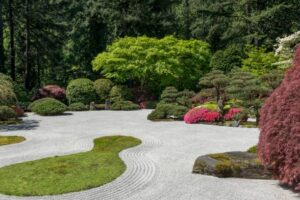Garden Design Adelaide: A Bridge Between Cultures
Japanese gardens are a fascinating and tranquil place to relax. This type of garden requires a delicate balance between beauty and function. It features a variety of unique elements and styles, including bridges that cross bodies of water, fences, gates, and sculptures.
One such feature is the pond. It’s a beautiful water feature and a symbol of purity and renewal. For more Japanese garden design in Adelaide, click here.
Green is the colour of tranquillity
 Using soothing shades of green in your Japanese garden is essential to its tranquil atmosphere. It’s also a symbol of renewal and the flow of life. The pond is a central focal point in Himeji Gardens and a powerful visual metaphor for purity, renewal, and harmony.
Using soothing shades of green in your Japanese garden is essential to its tranquil atmosphere. It’s also a symbol of renewal and the flow of life. The pond is a central focal point in Himeji Gardens and a powerful visual metaphor for purity, renewal, and harmony.
The flora at Himeji Japanese Garden is a thoughtful mix of traditional Japanese varieties and climate-appropriate plants. Pine, hinoki false cypress, camellias, and azaleas offer vibrant blooms in the spring and summer, while ferns and ornamental grasses add texture and movement to the understory.
Unlike the symmetrical balance of most European gardens, Japanese designs are more organic and less structured. Overcrowding your garden with too many elements will defeat its purpose, so don’t try to fill every space. Instead, scatter a variety of plant species in odd-numbered groups throughout your outdoor living area to create a natural look. Then, allow your gardens to grow, revealing their beauty and tranquillity one step at a time.
Water is the element of life
Water is vital in Japanese garden design, symbolising renewal, calm, and wonder. It can be represented literally in a pond or lake or figuratively in raked patterns in gravel reminiscent of ripples. Adding any type of bamboo water feature to your Japanese garden will enhance the overall beauty and create a soothing atmosphere for meditation. For more Japanese garden design Adelaide, click here.
Unlike many Western gardens that use a lot of bright colours to distract the eye, Japanese gardens prefer simplicity. A small tuft of moss or a single maple tree can be enough to draw the eye and provide texture.
You can find a perfect example of this in Himeji City, a sister city of Adelaide. This little pocket of Japan, built to commemorate the city’s 150th anniversary in 1986, is the work of landscape designer Yoshitaka Kumada and volunteers. Kumada has a secret to his success: he uses the irregular placement of plants and stones to create the feeling that natural landscapes are unplanned and not perfectly symmetrical.
Bamboo is a symbol of peace
Bamboo is a symbol of peace and tranquillity in Japanese culture. It is one of the fastest-growing plants in the world, and it can be used to create a decorative fence. It is also a popular choice for garden structures like bridges and pergolas.
In Japanese gardens, soothing shades of greys and browns are the primary palette, and flowers are used sparingly. Plants like evergreen trees and varieties of maple are often chosen, as they can maintain their vibrant green colour throughout the year.
The Adelaide Himeji Garden is a serene Japanese-style garden within walking distance of the city centre. It features a pond, a tea house, and winding stone paths focusing on meditation. The Himeji garden’s flora is a delightful blend of traditional Japanese plants and climate-appropriate selections. Its pond is a beautiful example of water’s essential role in Japanese-style gardens, demonstrating the element of life and renewal. The pond is adorned with lily pads, koi fish, and other aquatic plants that add an aesthetic to the garden. For more Japanese garden design Adelaide, click here.
Zen gardens are a place of meditation
This garden was designed to bridge the Adelaide and Himeji cultures, blending two classic Japanese garden styles: the’ Sensui’ (water garden) and the’ Kare-sansui’ (dry garden). The serene lake is home to more than water lilies and ducks; it’s also a bubbling world of goldfish, medaka fish, yabbies, and long-necked tortoises. Occasionally, the symphony of birds and breezes is punctuated by the clack of a Shishi-odoshi deer scarer.
In a Zen garden, the elements are carefully arranged to create vignettes that can’t be viewed simultaneously. This technique reflects simplicity, suggestion, and irregularity principles, which open the mind to meditation and enlightenment.
